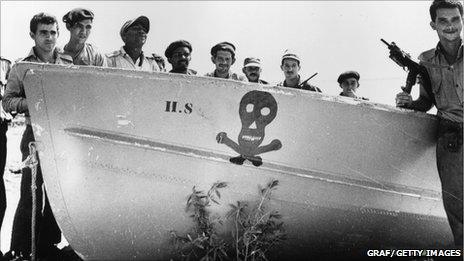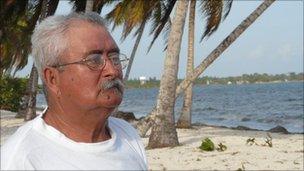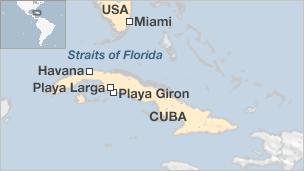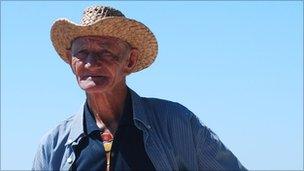Bay of Pigs: The 'perfect failure' of Cuba invasion
- Published

Fidel Castro's forces outnumbered the invaders by about 10 to one
Fifty years ago, shortly before midnight on 16 April 1961, a group of some 1,500 Cuban exiles trained and financed by the CIA launched an ill-fated invasion of Cuba from the sea in the Bay of Pigs.
The plan was to overthrow Fidel Castro and his revolution.
Instead, it turned into a humiliating defeat which pushed Cuba firmly into the arms of the Soviet Union and has soured US-Cuban relations to this day.
The Bay of Pigs is a large isolated inlet on Cuba's southern coast.
There is little here apart from mosquitoes and a crocodile-infested swamp.
The beach at Playa Giron, a village with a small airstrip at the mouth of the Bay of Pigs, was the invaders' primary target. (To this day, it is referred to in Cuba as the Playa Giron invasion.)
A simultaneous landing was planned near the village of Playa Larga, 35km away at the far end of the bay.
Flawed plans
An old, fortified concrete trench dug into the coconut palm-fringed beach is one of the only visible reminders of the historic battle.
Fidel Castro had ordered defences like these to be built at key points throughout the island - an invasion was widely expected, but no-one had any idea where it was going to land.
The American plan was to sneak ashore virtually unopposed, secure the area, take the airfield and fly in a government-in-exile who would then call for direct US support.

Domingo Rodriguez believes the attempted invasion was a turning point for Cuba
At the same time, they were relying on a mass uprising in Cuba against the revolutionaries.
It could not have gone more wrong: when an advance frogman lit a beacon to show the exiles where to land, it also alerted the Cuban militia to their presence.
Local fisherman Gregorio Moreira, who still lives in the same house beside the beach, was one of the first to raise the alarm.
"I went out of the house and saw a flare, like a candle, in the sky. So I headed to the trench with my father and my brothers," 74-year-old Mr Moreira recalls.
He was joined on the beach by one of his neighbours, another fisherman, Domingo Rodriguez.
"We thought, 'This is the invasion boys, be careful! They are trying to invade.'
"We had 11 rifles between us and at about 0400 they started the landing so we opened fire."
Michael Voss revisits the site of the Bay of Pigs invasion, and meets some of those who remember what happened on 16 April 1961
Reinforcements, including Cuban air force planes, quickly arrived.
The exiles had some air support, but US President John F Kennedy was determined to keep the US involvement a secret and as the initiative turned against the invading force, he backed away from providing further critically needed air cover.

At the same time, Fidel Castro took personal charge of the operation, and within only three days the battle was over.
Mr Rodriguez is now 70 years old and losing his eyesight but his memories are as clear as ever.
"It was like a great school for the Cuban people, we finally learnt that we don't have to be afraid of the enemy," he said.
"As Fidel said afterwards, the people of Latin America have become a little freer."
More than 1,000 of the anti-Castro fighters, known as Brigade 2506, were taken prisoner.
About a year-and-a-half later, they were sent back to Miami in exchange for $50m worth of food and medicine.
'Yankee defeat'
There is a small museum in Playa Giron.
In the forecourt are two of Fidel Castro's tanks, along with a British-built Sea Fury fighter bomber, one of the Cuban air force planes used against the invaders.
The museum's director, Barbara Sierra, says the exhibits are testimony to the "first great defeat of Yankee Imperialism" in the Latin America.
The US, she believes, completely underestimated the degree of support for Fidel Castro's revolution inside Cuba.
"The secret to the Cuban victory was the ideal for which we were fighting. Our lives were very difficult before the revolution. That's why everyone came here to fight."
Among the visitors to the museum when I visited was American author Peter Kornbluh, who has written extensively on the Bay of Pigs, drawing heavily on declassified CIA documents.

Gregorio Moreira still lives by the beach where the US-backed troops landed
He describes the Bay of Pigs as a "perfect failure" for the US, which the rest of the world quickly realised was behind the operation.
"It was supposed to rid the hemisphere of a potential Soviet base, but it pushed Fidel Castro into the waiting arms of the Soviet Union. It was meant to undermine his revolution but it truly helped him to consolidate it."
Half a century after the failed invasion, this Caribbean island remains the only communist-run country in the Western hemisphere.
Despite countless attempts by the CIA to assassinate Fidel Castro, it was ill health which finally forced him to hand over power in 2006 - to his brother, Raul.
It is no coincidence that the authorities have chosen this weekend to hold the long-delayed Communist Party Congress, which will kick off with a military parade through Revolution Square.
With the US trade embargo still in place, Cuba insists that it remains in a state of siege.
While it is set to ratify a series of market reforms, the Congress is also set to reaffirm the "socialist character of the revolution".
Political change remains no nearer now than it did following Cuba's victory at the Bay of Pigs.